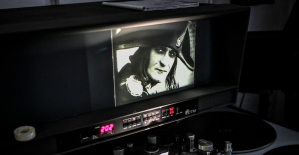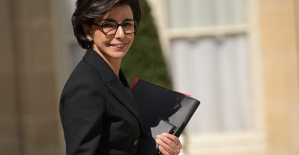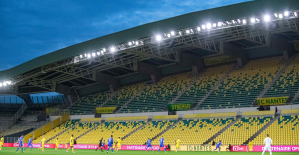Pittman -- elevated to acting chief after then-Chief Steven Sund was forced to resign in the aftermath of the deadly insurrection -- was passed over last month for the role of permanent chief. J. Thomas Manger was instead selected by the Capitol Police Board to oversee the force. He is the former chief for the Fairfax County, Virginia, and Montgomery County, Maryland police departments.
Pittman's tenure was marred by a vote against him as assistant chief and questions about intelligence failures and leadership failures.
However, Pittman was reappointed as the assistant chief of intelligence operations at the agency and the supervisor of officers who protect high-ranking congressional leaders. This is more than six years after the riot.
A Jan. 3 intelligence assessment by Capitol Police found that "supporters of the current President see Jan. 6, 2021 as the last chance to overturn the results in the presidential election." "This feeling of despair and disappointment could make it more tempting to commit violence."
Unlike past events, when pro-Trump supporters clashed violently with counter-demonstrations, "Congress itself is the target on the 6th," the assessment added.
Washington police officials are becoming more concerned about the September 18 rally on federal land near the Capitol. The organizers claim the rally is intended to demand justice for hundreds of people charged in January's rebellion. The organizers of the event, called "Justice for J6", claim it will be peaceful. However, law enforcement officials are concerned that a large gathering of thousands could quickly turn violent.
Given the turmoil that followed the riot, Pittman's continued position as intelligence chief is remarkable. Sund, Senate and House sergeants at arm and the other assistant police chief all resigned. However, it could be a concession from the department to her resignation that there was an intelligence problem.
According to Capitol Police, Pittman was given the "extra responsibility" of acting as the police chief temporarily. She never quit her job however, an organization chart obtained from The Associated Press shows that Sean Gallagher held the position of assistant chief for intelligence. He is temporarily in charge the uniformed officers of the department.
"In that temporary role, Chief Pittman managed the Department through many reviews. "She also directed and managed improvements to pivot USCP toward an intelligence-based protective agency," said the agency about Pittman's tenure as police chief.
Pittman, the temporary public face for the department, admitted to Congress that there were multiple failures that allowed pro-Trump protesters to storm the building. However, he denied that law enforcement failed to respond to the threat seriously. He also noted that Capitol Police had issued an internal warning document warning of extremists days before the riot.
Capitol Police has compiled intelligence documents that suggest the crowd could become violent and even target Congress.
The Associated Press obtained complete versions of four intelligence assessments by Capitol Police in December and January. These intelligence assessments warned that large crowds could reach the tens or thousands, and that they might include members of extremist groups such as the Proud Boys or Antifa. For example, a Jan. 3 memo warned of a "significantly hazardous situation for law enforcement as well as the general public."
However, none of these assessments could have predicted the violence that occurred when Trump loyalists took over the building. Police officials repeatedly stated that they did not know of any intelligence suggesting that such a thing would occur.
The most detailed Capitol Police intelligence document was the Dec. 21 assessment. It showed how people had been discussing and researching the tunnels beneath the Capitol. This is a common method of locating and using Capitol Police staff members. Similar warnings were contained in a Jan. 5 FBI memo sent from the Norfolk field office.
Pittman claimed that she had sent the Dec. 21 intelligence assessment to her command team, which included the chief and the other assistant chiefs and deputy chiefs. However, Jeffrey Pickett, a recently retired deputy chief, stated that he hadn't received the document and that he didn't know of any other senior officials who had.
Capitol Police officials stated that the department had "enhanced their security posture" due to intelligence that indicated increased interest in tunnels. A law enforcement official told AP that Pittman had emailed Chad Thomas and Sund about the tunnel information. As she testified, the department didn't say whether Pittman had sent the intelligence assessment to other chiefs.
The department stated in a statement that "what the intelligence did not reveal was that the large-scale demonstration would turn into a large scale attack on the Capitol Building because there was no specific credible intelligence about such an attack."

 Iran-Israel conflict: what we know about the events of the night after the explosions in Isfahan
Iran-Israel conflict: what we know about the events of the night after the explosions in Isfahan Sydney: Assyrian bishop stabbed, conservative TikToker outspoken on Islam
Sydney: Assyrian bishop stabbed, conservative TikToker outspoken on Islam Torrential rains in Dubai: “The event is so intense that we cannot find analogues in our databases”
Torrential rains in Dubai: “The event is so intense that we cannot find analogues in our databases” Rishi Sunak wants a tobacco-free UK
Rishi Sunak wants a tobacco-free UK Alert on the return of whooping cough, a dangerous respiratory infection for babies
Alert on the return of whooping cough, a dangerous respiratory infection for babies Can relaxation, sophrology and meditation help with insomnia?
Can relaxation, sophrology and meditation help with insomnia? WHO concerned about spread of H5N1 avian flu to new species, including humans
WHO concerned about spread of H5N1 avian flu to new species, including humans New generation mosquito nets prove much more effective against malaria
New generation mosquito nets prove much more effective against malaria The A13 motorway closed in both directions for an “indefinite period” between Paris and Normandy
The A13 motorway closed in both directions for an “indefinite period” between Paris and Normandy The commitment to reduce taxes of 2 billion euros for households “will be kept”, assures Gabriel Attal
The commitment to reduce taxes of 2 billion euros for households “will be kept”, assures Gabriel Attal Unemployment insurance: Gabriel Attal leans more towards a tightening of affiliation conditions
Unemployment insurance: Gabriel Attal leans more towards a tightening of affiliation conditions “Shrinkflation”: soon posters on shelves to alert consumers
“Shrinkflation”: soon posters on shelves to alert consumers The restored first part of Abel Gance's Napoléon presented at Cannes Classics
The restored first part of Abel Gance's Napoléon presented at Cannes Classics Sting and Deep Purple once again on the bill at the next Montreux Jazz Festival
Sting and Deep Purple once again on the bill at the next Montreux Jazz Festival Rachida Dati: one hundred days of Culture on the credo of anti-elitism
Rachida Dati: one hundred days of Culture on the credo of anti-elitism The unbearable wait for Marlène Schiappa’s next masterpiece
The unbearable wait for Marlène Schiappa’s next masterpiece Skoda Kodiaq 2024: a 'beast' plug-in hybrid SUV
Skoda Kodiaq 2024: a 'beast' plug-in hybrid SUV Tesla launches a new Model Y with 600 km of autonomy at a "more accessible price"
Tesla launches a new Model Y with 600 km of autonomy at a "more accessible price" The 10 best-selling cars in March 2024 in Spain: sales fall due to Easter
The 10 best-selling cars in March 2024 in Spain: sales fall due to Easter A private jet company buys more than 100 flying cars
A private jet company buys more than 100 flying cars This is how housing prices have changed in Spain in the last decade
This is how housing prices have changed in Spain in the last decade The home mortgage firm drops 10% in January and interest soars to 3.46%
The home mortgage firm drops 10% in January and interest soars to 3.46% The jewel of the Rocío de Nagüeles urbanization: a dream villa in Marbella
The jewel of the Rocío de Nagüeles urbanization: a dream villa in Marbella Rental prices grow by 7.3% in February: where does it go up and where does it go down?
Rental prices grow by 7.3% in February: where does it go up and where does it go down? With the promise of a “real burst of authority”, Gabriel Attal provokes the ire of the opposition
With the promise of a “real burst of authority”, Gabriel Attal provokes the ire of the opposition Europeans: the schedule of debates to follow between now and June 9
Europeans: the schedule of debates to follow between now and June 9 Europeans: “In France, there is a left and there is a right,” assures Bellamy
Europeans: “In France, there is a left and there is a right,” assures Bellamy During the night of the economy, the right points out the budgetary flaws of the macronie
During the night of the economy, the right points out the budgetary flaws of the macronie These French cities that will boycott the World Cup in Qatar
These French cities that will boycott the World Cup in Qatar Champions League: France out of the race for 5th qualifying place
Champions League: France out of the race for 5th qualifying place Ligue 1: at what time and on which channel to watch Nantes-Rennes?
Ligue 1: at what time and on which channel to watch Nantes-Rennes? Marseille-Benfica: 2.99 million viewers watching OM’s victory on M6
Marseille-Benfica: 2.99 million viewers watching OM’s victory on M6 Cycling: Cofidis continues its professional adventure until 2028
Cycling: Cofidis continues its professional adventure until 2028


















